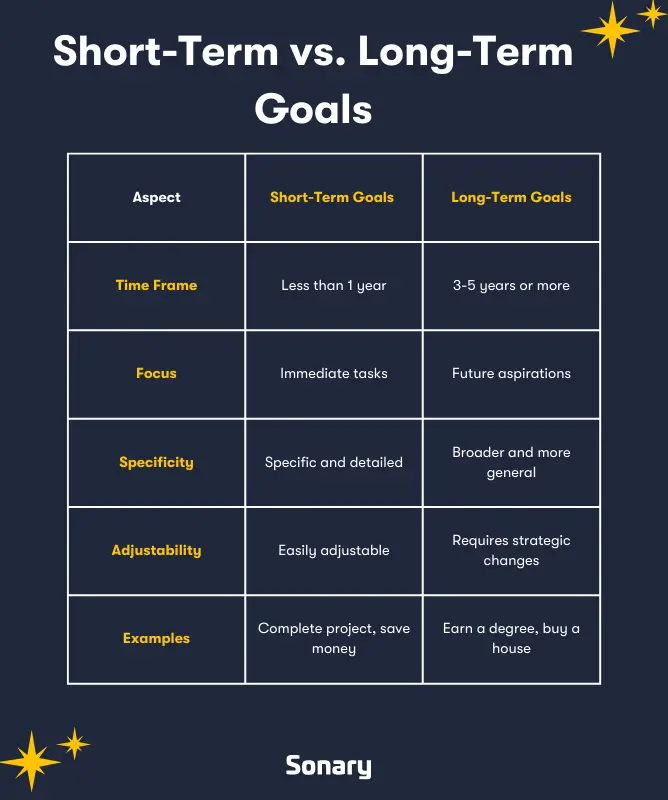Short-Term vs. Long-Term Goals: Your Path to Success

Setting goals is about creating a clear roadmap to your ideal future.
Dreaming of climbing the career ladder, living a healthier life, or mastering a new hobby? Goal setting is your secret weapon to make those aspirations come true. Start with crystal-clear goals and stay agile as life throws its curveballs. This way, you’ll keep your eyes on the prize and move steadily toward your objectives.
Tracking your progress and making adjustments as necessary will help you stay on course, ensuring that you remain supercharged and inspired every step.
Quick Summary: Short-Term vs. Long-Term Goals
- Short-term goals = quick wins (days to months)
Long-term goals = big-picture achievements (years) - Short-term keeps you motivated with immediate progress
Long-term keeps you focused on your future vision - Short-term is specific, flexible, and easy to adjust
Long-term is broader, more complex, and requires sustained effort - Use short-term goals as steps that lead to your long-term goals
- Apply the SMART method to both:
Specific, Measurable, Achievable, Relevant, Time-bound
Pro tip: Align both types to stay consistent, motivated, and on track.
Let’s explore some fantastic strategies to set impactful short-term and long-term goals that will steer you right and keep the excitement alive as you chase after that incredible future success you envision.

What is Goal Setting?
Goal setting is more than just writing down what you want to achieve. It’s about creating a structured plan that outlines your objectives and the steps needed to reach them. Effective goal setting involves identifying what’s important to you, breaking down your goals into manageable tasks, and setting deadlines to keep yourself accountable. Creating short-term goals alongside your long-term plans is essential, as it helps maintain motivation and ensures steady progress toward your bigger ambitions.
In your personal and professional lives, goal setting acts as a guiding force. It helps you stay focused on what matters most, avoid distractions, and make consistent progress. By setting clear, actionable goals, you can measure your achievements, celebrate your successes, and stay motivated to keep pushing forward.
The Importance of Setting Goals
Setting goals is a fundamental step in achieving success in any area of life. Goals provide direction, motivation, and a clear focus, allowing you to channel your efforts toward meaningful achievements. Here’s why goal setting is crucial:
- Provides Direction: Goals act as a roadmap, guiding you toward your desired destination. Without clear goals, it’s easy to drift aimlessly and lose sight of what you truly want to achieve.
- Breaks down goals into manageable steps: Setting goals also involves breaking them down into smaller, manageable steps. This makes it easier to start, maintain momentum, and tackle challenges systematically, turning daunting tasks into achievable victories.
- Increases motivation: Having specific goals gives you something to strive for and keeps you motivated. When you set goals, you create a sense of purpose and drive that pushes you to take action and make progress.
- Enhances focus: Goals help you concentrate your efforts on what’s important. By setting priorities and focusing on your objectives, you can avoid distractions and make the most of your time and resources.
- Measures progress:Goals provide a benchmark for measuring your progress. Tracking your achievements and seeing how far you’ve come can boost your confidence and encourage you to keep moving forward. Regularly tracking your progress helps maintain motivation and accountability, making it easier to adjust your strategies for continuous improvement.
- Builds Self-Discipline: Setting and working towards goals cultivates self-discipline and determination. It teaches you to stay committed, overcome obstacles, and develop the resilience needed to achieve long-term success.
- Encourages growth: Goals push you out of your comfort zone and challenge you to grow and improve. They inspire you to acquire new skills, gain knowledge, and expand your horizons.
If your goals require intricate planning and necessitate tight scheduling, there is software that can help you keep things on track:
Related Articles




Short-Term Goal vs. Long-Term Goal: What Are They?
Understanding the difference between long-term and short-term goals is essential for effective goal setting. Both types of goals play a vital role in your overall success, but they serve different purposes and timeframes. Here’s a closer look at what they are:
Short-Term Goals
Definition: Short-term goals are objectives that are set to be achieved in the near future, typically within a few days, weeks, or months. These goals are usually more immediate and specific, providing quick wins and incremental progress toward larger objectives.
Purpose: Short-term goals act as stepping stones towards your long-term aspirations. They break down big, overwhelming tasks into smaller, manageable actions, making it easier to stay focused and motivated.
Examples:
- Completing a project at work within a week.
- Saving a specific amount of money this month.
- Finishing a short online course in the next few weeks.
Characteristics:
- Time Frame: Days to months.
- Specificity: Often very specific and detailed.
- Measurability: Easier to measure progress and success.
- Adjustability: Can be easily adjusted based on immediate feedback and changing circumstances.
Long-Term Goals
Definition: Long-term goals are objectives set to be accomplished over an extended period, usually several years. These goals require significant planning, effort, and sustained commitment, often involving multiple stages or milestones. Long-term goals require a flexible, multi-stage approach and are achieved through multiple steps that demand strategic planning and perseverance.
Purpose: Long-term goals provide a sense of direction and purpose. They help you stay focused on your big-picture ambitions and guide your short-term efforts. Long term plans help align your current actions with future aspirations, ensuring that your short-term goals contribute to your overall vision. Achieving long-term goals often requires sustained effort, patience, and commitment.
Examples:
- Earning a degree in a specialized field.
- Building a successful business.
- Achieving financial independence.
- Buying a house.
Characteristics:
- Time Frame: More than a year.
- Broad Scope: Often broader and more comprehensive.
- Complexity: Typically more complex and multifaceted.
- Sustainability: Require ongoing effort and adjustment to maintain progress towards the end goal.
Short-Term vs. Long-Term Comparison
-
Time Frame:
- Short-Term: Achieved in days to months.
- Long-Term: Achieved in years.
-
Focus:
- Short-Term: Immediate tasks and quick wins.
- Long-Term: Sustained effort and overarching objectives.
-
Adjustability:
- Short-Term: Easily adjusted based on immediate needs and feedback.
- Long-Term: Requires flexibility but generally follows a more stable and strategic path.
-
Impact:
- Short-Term: Provides motivation and quick results.
- Long-Term: Offers direction, purpose, and significant achievements.
It’s important to note that not all goal-setting approaches are equally effective. Using a proven framework like SMART can help turn vague ideas into clear, actionable plans.
Short-Term vs. Long-Term Goals: The Difference
|
Aspect |
Short-Term Goals |
Long-Term Goals |
|
Timeline |
Days, weeks, or a few months |
Typically several years |
|
Number |
Often more numerous |
Usually fewer in number |
|
Strategy |
Focuses on immediate actions and quick wins |
Requires detailed planning and sustained effort |
|
Motivation |
Boosted by quick achievements and immediate rewards |
Driven by a larger vision and ultimate aspirations |
|
Difficulty |
Generally easier and more manageable |
Often more challenging and complex |
|
Flexibility |
Allows for more frequent changes and revisions |
Requires adaptability and long-term adjustments |
By recognizing these differences, you can effectively set both types of goals, ensuring that your short-term efforts align with and support your long-term ambitions. When setting short-term goals, be sure to consider your current resources to make your goals achievable and practical. This balanced approach will keep you motivated, focused, and on track to achieving your dreams.
How They Work Together
So, what best describes the relationship between short and long-term goals?
Short-term and long-term goals are interconnected and complement each other. Short term goals serve as the building blocks for achieving long-term success. By focusing on immediate tasks and milestones, you can make steady progress toward your larger objectives. Tracking progress through regular check-ins on these milestones ensures you stay on course and celebrate achievements.
For example, if your long-term goal is to run a marathon, your short-term goals might include gradually increasing your running distance, improving your diet, and following a training schedule. Each short-term achievement brings you one step closer to crossing the marathon finish line.
In summary, both short-term and long-term goals are essential for a balanced and effective goal-setting strategy. Short-term goals keep you motivated and provide quick wins, while long-term goals give you a clear vision and purpose for the future.
By understanding and setting both types of goals and throwing in a few mid-term goals to smooth the transition, like a quick 5K run, you can create a comprehensive plan that leads to lasting success.
Setting both types of goals helps maintain a balanced approach to personal and professional development.
Setting Effective Goals
Setting effective goals is crucial for achieving success. It’s not just about having a wish list; it’s about creating a strategic plan that guides your actions and decisions. One of the most effective ways to set goals is by using the SMART framework. Applying the SMART criteria ensures your goals are clear, focused, and achievable, making it easier to accomplish both short-term and long-term objectives.
SMART Goal Setting
SMART goal setting is a widely recognized method for creating clear and actionable goals. SMART stands for Specific, Measurable, Achievable, Relevant, and Time-bound. This framework ensures that your goals are well-defined and attainable, increasing your chances of success.
- Specific: Your goal should be clear and specific. Instead of saying, “I want to get fit,” specify what you want to achieve, such as “I want to run a 5K race.”
- Measurable: Your goal should be measurable so you can track your progress. For example, “I want to run a 5K race in under 30 minutes.”
- Achievable: Your goal should be realistic and attainable. Consider your current abilities and resources. For instance, “I will train three times a week to prepare for the race.”
- Relevant: Your goal should align with your values and long-term objectives. Ask yourself why this goal is important to you. For example, “Running a 5K will improve my health and fitness.”
- Time-bound: Your goal should have a deadline. This creates a sense of urgency and helps you stay focused. For instance, “I will run a 5K race by the end of the next three months.”
By setting SMART goals, you create a clear path to follow, making staying motivated and committed to achieving your objectives easier.
Creating a Goal-Setting Framework
Creating a goal-setting framework is essential for turning your aspirations into actionable plans. This framework will guide you in setting, tracking, and achieving your goals, ensuring that you stay focused and motivated. Including an accountability partner in your framework can provide valuable support, regular check-ins, and reminders to help you maintain momentum and achieve both short-term and long-term goals.
Define Your Vision
Defining your vision is the first step in creating a goal-setting framework. Your vision is a clear and compelling picture of what you want to achieve in your personal and professional life. For example, your long-term vision might include aspiring to a leadership role where you inspire and motivate others. It captures your values, priorities, and aspirations, serving as a guiding force for your goal-setting efforts.
To define your vision, take time to reflect on your values, strengths, and passions. Consider what you want to achieve in the short-term and long-term. Write down your vision statement and use it as a reference point for setting your goals. This vision will help you stay focused on what truly matters, ensuring that your goals align with your overall aspirations.
By defining your vision, you create a foundation for your goal-setting framework, making it easier to set specific, actionable, and meaningful goals that drive personal and professional growth.
How to Plan Short-Term Goals
Planning short-term goals is similar to planning long-term goals. Still, it relies on smaller wins and keeping motivation going on a daily basis to build momentum toward your larger aspirations. Here are steps to help you set and accomplish your short-term goals:
-
Identify Specific Objectives Start by clearly identifying what you want to achieve in the near future. Your short-term goals should be specific and focused on immediate outcomes. Example: “Improve my public speaking skills.”
-
Set SMART Goals: Ensure your short-term goals are Specific, Measurable, Achievable, Relevant, and Time-bound (SMART). This framework makes your goals clear and actionable. Example: “Deliver a five-minute presentation to my team without notes by the end of the month.”
-
Break Down Tasks: Divide your goal into smaller, manageable tasks. This makes it easier to take action and track your progress. Example: “1) Research effective public speaking techniques, 2) Write and practice my presentation, 3) Seek feedback from a colleague.”
-
Create a Timelin:e Establish a timeline with deadlines for each task. This keeps you organized and ensures you stay on track. Example: “Research techniques by the end of the first week, complete the presentation draft by the end of the second week, and practice with feedback by the third week.”
-
Prioritize tasks: Determine which tasks are most important and tackle them first. Prioritization helps you focus on what matters most and avoid procrastination. Example: “Focus on writing the presentation draft first, as it’s the foundation of the entire goal.”
-
Stay Flexible Be prepared to adjust your plans if necessary. Flexibility allows you to adapt to unexpected challenges and continue making progress. Example: “If I can’t find a colleague for feedback, I’ll use online forums or video recordings for self-evaluation.” Achieving a healthy work-life balance is crucial for maintaining productivity and motivation while working towards your goals.
-
Track Your Progress: Monitor your progress regularly to stay motivated and make any necessary adjustments. Tracking helps you see how far you’ve come and what still needs to be done. Example: “Set weekly check-ins to review progress and make adjustments to the timeline if needed.”
-
Celebrate Achievements: Recognize and celebrate your accomplishments, no matter how small. Take time to celebrate wins during regular check-ins, as this reinforces positive behavior and keeps your motivation high. Celebrations boost morale and reinforce the habit of goal setting and achievement. Example: “After delivering the presentation, treat yourself to something enjoyable, like a favorite meal or an evening off.”
-
Seek Support Share your goals with friends, family, or colleagues who can provide encouragement and hold you accountable. Support systems are valuable for staying motivated and overcoming obstacles. Example: “Tell a friend about your goal and ask them to check in on your progress.”
-
Reflect and Learn: After achieving your goal, take time to reflect on what worked well and what could be improved. Learning from your experiences helps you set even better goals in the future. Example: “Reflect on the presentation experience, noting strengths and areas for improvement, and apply these insights to future public speaking opportunities.”

How to Plan Long-Term Goals
Planning long-term goals is similar to planning short-term goals but ensures you stay focused on the bigger picture and motivated over an extended period. Here are steps to help you effectively plan and achieve your long-term goals:
-
Define Your Vision: Start by clearly defining your long-term vision. What do you want to achieve in the next 5, 10, or 20 years? Your vision should be ambitious yet realistic and reflect your ultimate aspirations. Example: “I want to become a certified project manager within the next five years.” When setting long-term goals, aim for sustainable growth—whether in business or personal development—by focusing on strategies that support continuous and resilient progress over time. Achieving these long-term goals can significantly enhance various aspects of your personal life, including health, finances, and relationships.
-
Break Down Your Goals: Divide your long-term goals into smaller, manageable milestones. These milestones will serve as checkpoints along your journey, making the larger goal seem less daunting and more achievable. These smaller goals then become your short term goals and should be planned using the previous structure. Example: “Complete a project management course in the first year, gain relevant work experience in the next two years, and prepare for the certification exam in the final two years.”
-
Set SMART Goals: As in short-term goals, ensure your objectives are SMART (Specific, Measurable, Achievable, Relevant, and Time-bound). This framework helps you create clear and actionable objectives. Example: “Complete the project management course with a grade of 90% or higher by December of this year.”
-
Create an Action Plan: Develop a detailed action plan outlining the steps needed to achieve each milestone. Include deadlines, resources required, and any potential obstacles you might face. Divide any complex steps into subtasks, and research how each can be achieved. Example: “Enroll in the project management course by January, dedicate 10 hours per week to studying, and join a study group for additional support.”
-
Stay Flexible and Adaptable: Life is unpredictable, and your path may change along the way. You’ll have to be flexible here, more than in short-term goals because over the years you and your needs may change and it’s important not to cling to old notions. Be prepared to adjust your goals and plans as needed. Flexibility allows you to adapt to new opportunities and challenges without losing sight of your long-term vision. Example: “If the course is not available, look for alternative certifications or online courses that can provide similar knowledge and credentials, or check in to see if this is the optimal path.”
-
Monitor Progress and Celebrate Milestones: Review your progress regularly and celebrate when you reach significant milestones. This will help you stay motivated and maintain a positive attitude toward your goals. These celebrations should probably be more substantial than after a small victory. Example: “Review progress every quarter and reward yourself with a night out or a weekend away after completing a major milestone.”
-
Seek Support and Accountability: Share your goals with friends, family, or mentors who can offer support and hold you accountable. Joining a community or finding a mentor can provide valuable guidance and encouragement. Example: “Discuss your goals with a mentor in the project management field and schedule monthly check-ins to review your progress.”
-
Reflect and Adjust: Periodically reflect on your goals and the progress you’ve made. Assess what’s working and what’s not, and make necessary adjustments to stay on track. If while studying for your project management certification, you’ve sparked an interest in a specific aspect of the field, you can always add specialization courses to become an expert in your field. Example: “At the end of each year, reflect on your achievements, identify areas for improvement, and adjust your plan for the upcoming year.”
With the right balance of focus and flexibility, you’ll be able to achieve your goals, without feeling locked in to a path that no longer suits your needs.

Short-Term and Long-Term Goals: Examples
Understanding the difference between short-term and long-term goals is crucial for effective planning. Let’s dive into some short and long-term goals examples to illustrate how you can set both types of goals to achieve your aspirations.
|
Category |
Short-Term Goals |
Long-Term Goals |
|
Career Development |
Complete an online course on project management within the next two months. |
Earn a Master’s degree in your field within the next five years. |
|
Update and polish your resume by the end of this week. |
Obtain a senior management position in your company within the next seven years. |
|
|
Schedule a meeting with your supervisor to discuss career advancement opportunities within the next month. |
Build and grow your own successful business over the next decade. |
|
|
Health and Fitness |
Start a daily 30-minute exercise routine and maintain it for the next six weeks. |
Run a full marathon within the next two years. |
|
Drink eight glasses of water every day for the next month. |
Achieve and maintain a healthy weight by adopting a balanced diet and regular exercise over the next three years. |
|
|
Prepare and eat at least three home-cooked meals each week for the next two months. |
Develop a consistent yoga practice and achieve advanced proficiency within the next five years. |
|
|
Personal Growth |
Read one book on personal development or self-improvement within the next four weeks. |
Write and publish a book within the next seven years. |
|
Practice mindfulness meditation for 10 minutes every morning for the next 30 days. |
Travel to at least 10 different countries and immerse yourself in their cultures within the next decade. |
|
|
Dedicate 15 minutes each day for the next three months to learning a new skill, such as playing a musical instrument or speaking a new language. |
Become fluent in a new language within the next five years. |
Tracking Progress
Tracking progress is the engine that keeps your goal-setting journey moving forward, whether you’re working toward short-term wins or ambitious long-term objectives. It’s not just about checking boxes—it’s about maintaining focus, building momentum, and ensuring you’re always on the right track toward personal and professional growth.
To effectively track progress, begin by selecting tools and techniques that align with your lifestyle and goals. Journals, spreadsheets, and mobile apps can all help you monitor milestones, set reminders, and receive immediate feedback on your achievements. For example, if your long-term goal is financial independence, you might use a spreadsheet to track your monthly savings plan and monitor the growth of your emergency fund. This approach provides a clear snapshot of your progress and helps you adjust your strategy as needed, especially when working toward goals that require a sustained commitment over an extended period.
Accountability partners can also play a pivotal role in tracking progress. Whether it’s a friend, mentor, or colleague, having someone to share your goals with can provide encouragement, guidance, and a gentle nudge when your motivation dips. This is especially valuable for long-term ambitions, such as climbing the career ladder or pursuing personal development, where the journey may span several years and require continuous improvement.
Setting specific, measurable milestones is another key to successful tracking. For short-term goals—those you aim to achieve in a relatively short time frame, such as less than a year—set daily or weekly targets. For instance, if you’re working on improving your time management skills, you might track the number of tasks you complete each day or the professional networking events you attend each month. These short-term targets provide immediate progress and feedback, helping you stay motivated and focused.
When it comes to long-term goals, tracking progress requires a more strategic approach. Break your long-term objectives into smaller, actionable steps and set checkpoints along the way. For example, suppose your long-term ambition is to become a leader in your particular field. In that case, you might set milestones like completing an online course, attending industry networking events, or taking on new project management responsibilities. By tracking your progress on a weekly or monthly basis, you can celebrate small wins, adjust your plan as needed, and maintain your overall direction.
One of the key differences between tracking short-term and long-term goals is the time frame and feedback loop. Short-term goals, achieved in a matter of weeks or months, offer quick wins and immediate feedback, making it easier to stay engaged. Long-term goals, on the other hand, require patience, a strategic plan, and the flexibility to adapt as circumstances change. By understanding these differences and tracking your progress accordingly, you can ensure that your short-term efforts are building blocks toward your broader objectives.
Celebrating small wins along the way is essential for maintaining motivation, especially when working toward long-term goals that may take years to accomplish. Each milestone reached—whether it’s saving a set amount in your emergency fund, completing a project management course, or expanding your professional network—deserves recognition. These celebrations reinforce your commitment to continuous improvement and help you stay focused on your long-term vision.
In summary, tracking progress is a vital part of successful goal setting. By using the right tools, setting clear milestones, leveraging accountability partners, and celebrating achievements, you can stay motivated and on track—no matter how ambitious your goals may be. Whether you’re aiming for immediate progress with a short-term goal or working steadily toward long-term ambitions, tracking your journey ensures that every step you take leads to greater personal and professional growth.
Prioritizing Your Goals
Why is it important to list and prioritize your short-, mid-, and long-term goals ahead of time?
Setting goals is a crucial step toward achieving success, but it’s equally important to prioritize them. By taking the time to organize your goals, you set yourself up for a more focused, efficient, and successful journey toward achieving your aspirations.
Here’s why:
-
Provides Clarity and Focus
Prioritizing your goals helps you clearly understand what needs to be accomplished first. This clarity enables you to focus your efforts on the most important tasks, ensuring that you use your time and resources effectively.
Example: If your long-term goal is to become a senior manager, a short-term priority might be to complete relevant training programs, while a mid-term priority could be to gain specific project management experience. -
Enhances Time Management
When you have a prioritized list of goals, you can allocate your time more efficiently. By knowing what to tackle first, you avoid wasting time on less critical tasks and ensure that you’re always making progress towards your most important objectives.
Example: You can ensure that you spend time on activities that contribute directly to your long-term goals, such as working on important projects, rather than getting sidetracked by minor tasks. -
Maintains Motivation and Momentum
Seeing progress in your short term goals can provide a motivational boost and help maintain momentum towards your longer-term aspirations. By achieving smaller milestones, you build the confidence to continue working towards your bigger goals.
Example: Celebrating the completion of a short-term or mid-term goal, like finishing a course, can give you the encouragement needed to tackle more challenging long-term goals. -
Improves Decision-Making
Having a clear hierarchy of goals aids in decision-making. When faced with multiple tasks or opportunities, you can refer to your prioritized list to determine which actions align best with your top priorities and long-term vision.
Example: If you have to choose between attending a networking event and working on a critical project, your prioritized goals will guide you to make the choice that best supports your career development. -
Reduces Overwhelm and Stress
A well-organized list of priorities helps prevent overwhelm by a long list of goals. By breaking down your ambitions into manageable parts and tackling them in order of importance, you reduce stress and make the process more manageable.
Example: Instead of feeling overwhelmed by the goal of starting your own business, you can focus on immediate steps like writing a business plan or researching the market, making the overall goal feel more attainable. -
Ensures Balanced Progress
Prioritizing your goals ensures that you’re making balanced progress across different areas of your life, whether personal, professional, or health-related. This balance helps you achieve holistic success and avoid neglecting any important aspect of your life.
Example: By prioritizing both career-related goals and personal health goals, you ensure that you’re advancing in your professional life while also taking care of your well-being. -
Facilitates Adaptability
When you have a clear list of priorities, it’s easier to adapt and re-prioritize when unexpected changes occur. This flexibility allows you to stay on track even when life throws you a curveball.
Example: If a sudden opportunity arises, like a job offer, you can quickly reassess your goals and adjust your priorities to align with the new situation.
Final Thoughts
The path to achieving your dreams is rarely straightforward, but with determination, flexibility, and a positive mindset, you can navigate any obstacles that come your way.
Setting and achieving your goals is a journey filled with opportunities for growth, learning, and self-discovery. By clearly defining your short-, mid-, and long-term goals and prioritizing them effectively, you lay a strong foundation for a successful and fulfilling future.
Celebrate your progress, no matter how small, and stay motivated by the vision of your ideal future. Each step you take brings you closer to your aspirations, and every achievement is a testament to your hard work and perseverance.
Keep your goals in sight, stay adaptable, continue pushing forward with confidence and enthusiasm, and keep dreaming big.
FAQs
- What are the benefits of setting both short-term and long-term goals?
Setting both provides immediate milestones for motivation and a clear vision for the future, ensuring continuous progress. - How can I stay motivated when working towards long-term goals?
Break down goals into smaller tasks, set milestones, celebrate achievements, and adjust plans as needed to stay engaged. - Why is it important to prioritize my goals?
Prioritizing goals helps you focus on what matters most, manage your time efficiently, and reduce overwhelm. - How do I balance personal and professional goals?
Create a list of priorities, allocate time for both, and ensure balanced progress across all areas of your life.
- What are short term goals?
Short-term goals are objectives that you aim to achieve in the near future, typically within a few days, weeks, or months. They are stepping stones toward achieving long-term goals. - What are long-term goals?
Long-term goals are objectives set to be accomplished over an extended period, usually several years. These goals require significant time, planning, and effort to achieve. - Why is it important to set both short-term and long-term goals?
Setting both types of goals helps maintain a balanced approach to personal and professional development. Short-term goals provide immediate motivation and a sense of achievement, while long-term goals offer direction and purpose. - How do short-term goals support long-term goals?
Short-term goals act as milestones or steps that lead to the achievement of long-term goals. They help break down larger objectives into manageable tasks, making the overall goal more attainable. - Can short-term goals change over time?
Yes, short-term goals can change based on progress, feedback, and changing circumstances. They are more flexible and can be adjusted to better align with evolving long-term goals. - How should one prioritize short-term and long-term goals?
Prioritization depends on urgency and importance. Short-term goals should be prioritized if they are immediate steps needed for progress, while long-term goals should be prioritized for strategic planning and sustained efforts. - What are some examples of short-term goals?
Examples include finishing a project at work within a week, saving a specific amount of money this month, or completing a short course within a few months. - What are some examples of long-term goals?
Examples include earning a degree, buying a house, achieving financial independence, or building a successful career in a specific field. - How can one effectively track progress toward short-term and long-term goals?
Use tools like to-do lists, calendars, and project management apps for short-term goals. For long-term goals, create a detailed plan with milestones, regularly review progress, and adjust strategies as needed. - What are common challenges in achieving short-term and long-term goals?
Common challenges include procrastination, lack of motivation, insufficient planning, unforeseen obstacles, and difficulty in maintaining focus. Regularly revisiting and adjusting goals can help overcome these challenges.


